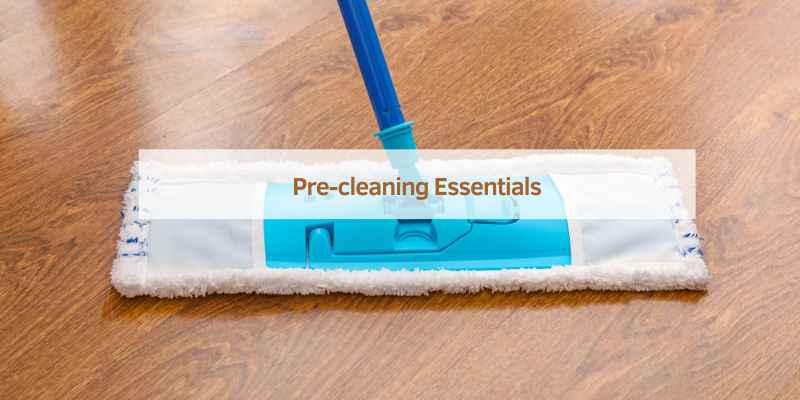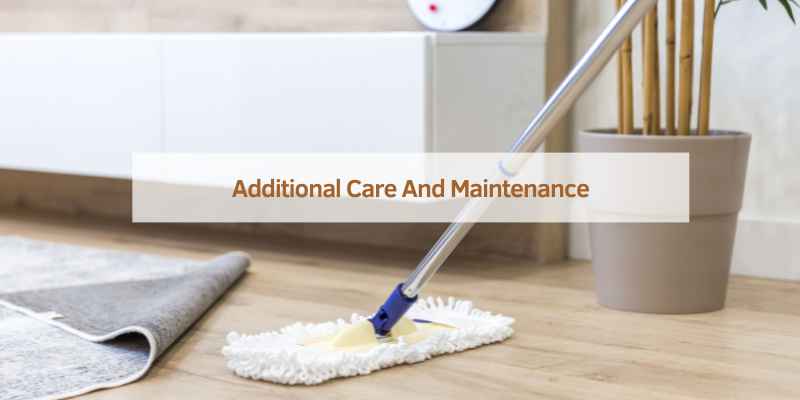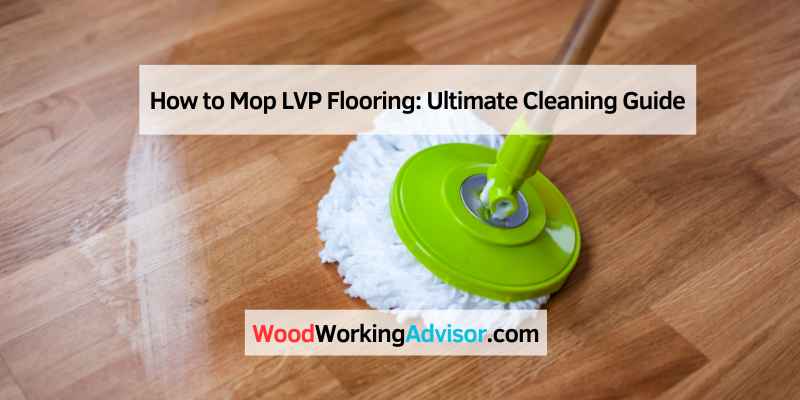To mop LVP flooring, start by dry mopping with a microfiber pad to pick up dirt and dust. Mix warm water with mild dish soap or vinegar, then mop the floors in a gentle, linear motion.
Avoid using steam cleaners, wax, or sealants on LVP flooring. Regular mopping with a vinyl-friendly solution helps maintain the cleanliness and appearance of your floors without causing damage. Remember to dry the floors quickly after mopping to prevent moisture damage and maintain the longevity of your luxury vinyl plank flooring.
Proper cleaning techniques will keep your LVP floors looking fresh and attractive for years to come.
Introduction To Lvp Flooring Maintenance
Maintaining LVP flooring is essential for its longevity, and knowing how to properly mop it is crucial. To mop LVP flooring, start by dry mopping to remove loose dirt, then use a mild dish soap mixed with warm water to clean the floors.
Avoid using steam cleaners, wax, or sealants, and opt for a pH-neutral floor cleaner for best results.
Luxury Vinyl Plank (LVP) flooring has gained immense popularity due to its durability, water resistance, and low maintenance requirements. To ensure the longevity and aesthetic appeal of your LVP flooring, it’s crucial to implement proper maintenance practices. In this guide, we will explore the essential aspects of caring for LVP flooring, including the benefits of proper care and common mistakes to avoid.
Benefits Of Proper Lvp Care
- Enhances Longevity: Regular maintenance preserves the integrity of the flooring, extending its lifespan.
- Preserves Aesthetic Appeal: Proper care prevents the accumulation of dirt, stains, and scratches, maintaining the floor’s visual appeal.
- Cost-Effective: By preventing damage and wear, consistent maintenance reduces the need for costly repairs or replacements.
- Healthier Indoor Environment: Regular cleaning eliminates allergens and germs, contributing to a healthier living space.
Common Mistakes To Avoid
- Using Harsh Cleaners: Avoid abrasive cleaners or chemicals that can damage the protective top layer of the flooring.
- Improper Mopping Techniques: Refrain from using excessive water or steam, as it can seep into the seams and cause damage.
- Neglecting Regular Cleaning: Failing to routinely clean the LVP flooring can lead to the accumulation of dirt and grime, impacting its appearance and longevity.
- Skipping Protective Measures: Avoid neglecting the use of furniture pads and mats to prevent scratches and dents on the flooring.
Pre-cleaning Essentials
Essential pre-cleaning steps are crucial for mopping LVP flooring effectively. Begin by dry mopping with a microfiber pad to remove dirt and dust thoroughly. Follow up with a gentle cleaning solution to maintain the cleanliness and shine of your luxury vinyl plank floors.
The Importance Of Dry Mopping
Dry mopping is a crucial step in preparing your LVP (Luxury Vinyl Plank) flooring for a thorough clean. This initial dry mop helps to remove loose dirt, hair, and dust, preventing them from being spread around during the wet mopping process. It is essential to prioritize dry mopping as it ensures a cleaner and more effective final result.
Choosing The Right Vacuum For Lvp
When it comes to selecting a vacuum cleaner for your LVP flooring, there are a few factors to consider. Firstly, choose a vacuum that is specifically designed for hard floors. These vacuums typically have adjustable settings and gentle bristles that won’t scratch or damage the surface of your LVP. Additionally, opt for a vacuum with a powerful suction to effectively remove debris from the grooves and crevices of the flooring. By choosing the right vacuum cleaner, you can ensure a thorough and efficient cleaning process.
Now that we understand the importance of pre-cleaning essentials, let’s dive deeper into each aspect to ensure your LVP flooring remains spotless and well-maintained.

Selecting The Best Mop For Lvp
When it comes to cleaning your luxury vinyl plank (LVP) flooring, selecting the right mop is crucial to ensure effective cleaning without causing any damage. The right mop not only helps in removing dirt and grime but also maintains the shine and durability of your LVP floors. Let’s explore the types of mops that are best suited for LVP and those that should be avoided.
Types Of Mops To Use
Using the right mop is essential to keep your LVP flooring in top condition. Here are the types of mops that are ideal for cleaning LVP:
- Microfiber Mops: These mops are gentle on LVP flooring and effectively pick up dirt and debris without leaving behind any scratches.
- Spray Mops: Designed for convenience, spray mops allow you to control the amount of cleaning solution applied, preventing excess moisture from seeping into the seams of the LVP.
- Flat Mops: With their low-profile design, flat mops are great for reaching under furniture and into tight spaces, ensuring thorough cleaning of the entire LVP surface.
Mops To Steer Clear Of
While certain mops may seem convenient, they can potentially harm your LVP flooring. It’s best to avoid the following types of mops:
- Steam Mops: The high heat and moisture from steam mops can damage the protective wear layer of LVP, leading to warping and distortion.
- String Mops: These traditional mops tend to retain excess water, increasing the risk of water seeping into the seams and causing damage to the LVP.
- Scrubbing Mops: Mops with abrasive scrubbing pads can scratch and wear down the surface of LVP, diminishing its visual appeal over time.
Understanding Cleaning Solutions
Safe Cleaners For Lvp
- Choose pH-neutral cleaners for LVP floors
- Avoid harsh chemicals that can damage the flooring
- Look for cleaners specifically designed for vinyl plank floors
Diy Cleaning Mixtures
- Mix water with a mild dish soap for a gentle cleaning solution
- Vinegar and water solution can be effective for disinfecting
- Avoid using abrasive cleaners that can scratch the LVP surface
The Mopping Process
To mop LVP flooring effectively, start by dry mopping with a sweeper or dry mop to pick up dirt and dust. Then, mix a gentle cleaning solution of warm water and mild dish soap to mop the floors. Ensure to avoid using steam cleaners or wax on LVP flooring to maintain its quality and appearance.
Step-by-step Mopping Guide
Properly mopping your LVP flooring is essential to maintain its beauty and longevity. Follow these step-by-step instructions to ensure a thorough and effective cleaning:
- Start by sweeping or vacuuming the floor to remove loose dirt and debris. This prevents scratching the surface during the mopping process.
- Fill a bucket with warm water and add a small amount of gentle floor cleaner. It’s important to use a cleaner specifically formulated for vinyl flooring to avoid damage.
- Dip a mop or microfiber cloth into the cleaning solution, making sure to wring out any excess water. Excessive moisture can seep into the seams and cause damage to the floor.
- Begin mopping the floor, working in small sections at a time. Use gentle, back-and-forth motions to effectively clean the surface. Remember to apply light pressure to avoid pushing dirt and water into the seams.
- If you encounter stubborn stains or dirt, you can use a soft-bristle brush or a non-abrasive sponge to gently scrub the affected area. Be careful not to use excessive force, as this can damage the protective layer of the LVP flooring.
- Once you’ve finished mopping, rinse the mop or cloth thoroughly and go over the floor again with clean water to remove any cleaning residue.
- Allow the floor to air dry completely before walking on it again. This helps prevent slipping and ensures a streak-free finish.
Frequency Of Mopping
How often you should mop your LVP flooring depends on the level of foot traffic in your home. Here are some general guidelines:
- For high-traffic areas, such as entryways and kitchens, it’s recommended to mop once a week or as needed.
- For low-traffic areas, such as bedrooms and guest rooms, mopping once every two weeks or once a month should be sufficient.
- Keep in mind that spills and stains should be addressed immediately to prevent any potential damage to the flooring.
By following this step-by-step mopping guide and adjusting the frequency based on your specific needs, you can keep your LVP flooring looking clean and beautiful for years to come.
Addressing Tough Stains And Spills
To effectively mop LVP flooring and address tough stains and spills, start by dry mopping the floors to remove loose dirt and debris. Then, mix a solution of warm water and a few squirts of mild dish soap in a bucket.
Use a damp mop or microfiber mop to gently clean the floors, focusing on the stained areas. Avoid using steam cleaners, wax, or sealants, as they can damage the LVP flooring. Finally, allow the floors to air dry or use a dry mop to quickly dry the surface.
Addressing Tough Stains and Spills on LVP flooring can be a challenging task, but with the right approach, you can keep your floors looking clean and new. Whether it’s a spilled drink or a stubborn stain, knowing how to address these issues is crucial to maintaining your flooring. In this section, we will explore some effective methods for cleaning and removing tough stains and spills from LVP flooring.
Immediate Action For Spills
When it comes to spills, the key is to act quickly. The longer a spill sits on your flooring, the more difficult it will be to remove. Here are some immediate actions you can take:
- Use a clean, dry cloth or paper towel to blot up as much of the spill as possible.
- Avoid using a scrubbing motion, as this can push the spill further into the flooring.
- If the spill is sticky or greasy, use a mild soap solution to clean the affected area.
- Rinse the area thoroughly with clean water and dry it with a clean cloth.
Dealing With Stubborn Stains
Sometimes spills can leave behind stubborn stains that require a bit more effort to remove. Here are some effective methods for dealing with stubborn stains:
- Vinegar Solution: Create a solution of equal parts water and vinegar, and apply it to the stain. Let it sit for a few minutes, then scrub the area with a soft-bristled brush. Rinse with clean water and dry with a clean cloth.
- Baking Soda Paste: Mix baking soda and water to create a paste, and apply it to the stain. Let it sit for 5-10 minutes, then scrub with a soft-bristled brush. Rinse with clean water and dry with a clean cloth.
- Hydrogen Peroxide: Apply a small amount of hydrogen peroxide to the stain and let it sit for a few minutes. Scrub the area with a soft-bristled brush, then rinse with clean water and dry with a clean cloth.
- Commercial Stain Remover: If all else fails, you can try using a commercial stain remover specifically designed for LVP flooring. Be sure to follow the manufacturer’s instructions carefully.
By following these methods, you can effectively address tough stains and spills on your LVP flooring, keeping it looking clean and new for years to come. Remember to always test any cleaning solution on a small, inconspicuous area of your flooring before using it on a larger stain to ensure that it won’t cause any damage.
Drying And Buffing
After mopping your LVP flooring, the drying and buffing process is crucial to achieving a pristine finish. Here’s how to ensure your floors dry quickly and achieve a polished look.
Pro Tips For Quick Drying
- Avoid excess water: Wring out the mop thoroughly to remove excess water before mopping the floor.
- Use fans: Position fans in the room to improve air circulation and expedite the drying process.
- Open windows: Allowing fresh air to flow through the room can aid in drying the floor faster.
Achieving A Polished Finish
Once the floor is dry, buffing can enhance its appearance and ensure a polished finish. Here are some steps to achieve this:
- Use a microfiber cloth: Buff the floor using a clean, dry microfiber cloth to remove any streaks or water marks.
- Apply floor polish (optional): If desired, apply a thin layer of floor polish to add a glossy shine to the LVP flooring.
- Regular maintenance: Periodically buff the floor to maintain its polished look and extend its longevity.
Protecting Your Lvp Flooring
When it comes to caring for your luxury vinyl plank (LVP) flooring, it’s essential to protect it from damage during cleaning and maintenance. Whether you have just installed new LVP flooring or want to ensure the longevity of your existing floors, taking the right protective measures is crucial. Protecting your LVP flooring not only maintains its aesthetic appeal but also preserves its durability and functionality over time.
Avoiding Harmful Products
When cleaning your LVP flooring, it’s important to avoid using harmful products that can cause damage. Avoid harsh chemicals, abrasive cleaners, and ammonia-based solutions as they can lead to discoloration, fading, or even peeling of the floor’s finish. Additionally, steer clear of steam cleaners and wax or sealant applications, as these can compromise the integrity of the flooring material. Instead, opt for gentle, vinyl-friendly cleaning solutions to ensure the long-term protection of your LVP floors.
Protective Measures Post-cleaning
After cleaning your LVP flooring, implementing protective measures can help safeguard it from potential damage. Place doormats at entryways to prevent dirt, grit, and moisture from being tracked onto the floors. Use felt pads or furniture protectors under heavy furniture to prevent scratches and dents. Regularly trim your pets’ nails to minimize the risk of scratches on the floor’s surface. By taking these protective measures, you can maintain the pristine condition of your LVP flooring and extend its lifespan.
Additional Care And Maintenance
To mop LVP flooring, start by dry mopping with a microfiber pad to pick up dirt and dust. Then, mix a gentle solution using water and a small amount of mild dish soap, and mop the floors using this solution.
Avoid using steam cleaners, wax, or sealants, and make sure to dry the floors quickly with a dry mop or towel to prevent any damage.
Additional Care and Maintenance of LVP Flooring
LVP (Luxury Vinyl Plank) Flooring is a popular choice among homeowners due to its durability, affordability, and low maintenance. While routine care and maintenance can help keep your LVP flooring looking its best, there are additional steps you can take to extend its lifespan and prevent damage. In this section, we will discuss some additional care and maintenance tips for LVP flooring, including routine care tips and when to call professionals.
Routine Care Tips
Routine care is essential to maintain the appearance and longevity of your LVP flooring. Here are some routine care tips to keep your LVP flooring in top condition:
- Use a dry mop or a sweeper with dry disposable or reusable microfiber pads to pick up dirt, hair, and dust. Make sure to go all the way to the baseboards and corners, and use gentle, linear motions to prevent spreading dust around.
- For deeper cleaning, use a neutral pH floor cleaner specifically designed for LVP flooring. Avoid using harsh chemicals, abrasive cleaners, or steam cleaners, as they can damage the flooring.
- When mopping, use a damp mop or a microfiber mop with a vinyl-friendly cleaning solution. Avoid using excess water, as it can seep into the seams and cause damage.
- Wipe up spills immediately to prevent staining or damage to the flooring.
- Avoid dragging heavy furniture or appliances across the flooring, as it can scratch or dent the surface. Use furniture pads or lift and carry the objects instead.
When To Call Professionals
While routine care can help prevent damage and maintain the appearance of your LVP flooring, there are times when you may need to call professionals for additional care or maintenance. Here are some situations where you may need to seek professional assistance:
- If your LVP flooring has deep scratches, dents, or gouges that cannot be repaired with routine care, you may need to have the affected planks replaced by a professional.
- If your LVP flooring has been exposed to excessive moisture or water damage, a professional can assess the damage and recommend the best course of action, which may include replacing the damaged planks.
- If you are unsure about the type of cleaning solution or method to use on your LVP flooring, consult with a professional to avoid damaging the flooring.
In conclusion, additional care and maintenance can help extend the lifespan and prevent damage to your LVP flooring. By following routine care tips and seeking professional assistance when necessary, you can keep your LVP flooring looking its best for years to come.

Frequently Asked Questions
What Is The Best Way To Clean Lvp Flooring?
The best way to clean LVP flooring is to start by dry mopping or vacuuming to remove loose dirt. Then, mix a solution of warm water and mild dish soap or vinegar to mop the floors. Avoid using steam cleaners, wax, or sealants.
Use a gentle, vinyl-friendly solution for deeper cleaning.
Is It Ok To Mop Vinyl Plank Flooring?
Yes, it is okay to mop vinyl plank flooring. Regular mopping with water is recommended, or use a gentle homemade cleaning solution for deeper cleaning.
Can I Use Swiffer Wet Pads On Vinyl Plank Flooring?
Yes, you can use Swiffer wet pads on vinyl plank flooring for effective cleaning and maintenance.
Can I Use Dawn To Clean Vinyl Plank Flooring?
Yes, you can use Dawn to clean vinyl plank flooring as it effectively cuts grime and grease without damaging the floors.
Conclusion
Maintaining LVP flooring is easy with regular gentle mopping using water or a mild soap solution. Remember to dry mop first to remove debris and avoid steam cleaners or harsh chemicals. By following these simple steps, your luxury vinyl plank floors will stay clean and beautiful.

